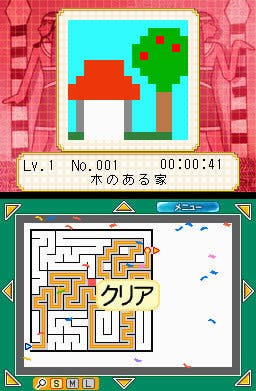Pic Pic
This year's Slitherlink!
Again, as with the other two, you end up creating a picture on the top screen. The further you get, the larger the grids, and the more complex this picture can be. By puzzles 200 to 400, you're often creating some really rather fantastic images, incomparable with the blocky blobs of the first few. Epic sunset scenes, waterfalls, sporting events. Puzzle 259 is a stream running through a forest. 314 is the MI6 Building in London. My absolute favourite is 371 - a gorgeously lit (no, seriously) pixel picture of a rabbit in the early evening, by some reeds.
Every so often the game switches from black and white to colour puzzles, with - I think - about two thirds ending up colour. Colour is only slightly different - with these you need to match the number and the colour. So a brown 4 connects to another brown 4, perhaps inside a red 12. This has the effect of simplifying the puzzles slightly - there's far fewer uncertainties when so many are clearly not ever going to connect - but increases the fun. The picture you build is that bit more entertaining to watch build up above, and by the time the grids are utterly vast, the black and whites can be unnerving.
It is just such a perfectly formulated, perfectly executed puzzle. It's distinct from anything in the wonderful Hudson Soft Puzzle collection, but as smartly and intuitively designed. In fact, it's in many ways better than the Hudson games, and not just because it's all in English. (It's so great to be able to turn the music off without having to attend evening classes). The control set-ups for each puzzle are astonishing, letting you reassign every button on the machine to some obscure flourish. (Except for letting you change between black and white in Magipic, madly!).

The only way in which it falls short of a Hudson title is the lack of a reward system for timely completion. While the omission doesn't hurt the game at all, it would have added another layer. Beating your previous time, and thus earning extra stars, is an excellent incentive for repeat play. However, in a puzzle game with 1200 superb puzzles, demanding that is perhaps a little excessive. And speaking as someone who's played 800 Drawing puzzles, it certainly didn't cause me to want to carry on any less.
So what you have here is a puzzle as inspired and delightful as Slitherlink, and in a game as neatly executed as Hudson's classic. Then either side of it are two other puzzle games, the slightly less interesting Maze Paint, and the slightly more fiddly Magipic, like lovely bridesmaids either side of the gorgeous bride. I told you this was romantic.
I have other things to celebrate about it, but I should probably stop. But let me mention the mad naming of some of the puzzles. They're not named until you've completed them, to ensure it's not spoilt. My favourite. A fox, with a golf club by a flaghole, with two foxes watching on in the background. The title? "Golf". Wonderful.
Confuse your local game store by making them order it in. Confuse 505 Games by having their eight-month-old game suddenly chart. (It's not in stock everywhere, but most places have "used and new" copies). Hell, if it's hard to find, we'll all force them to reissue it. It was released for Italy only this month, so we know they're still taking notice of it.








